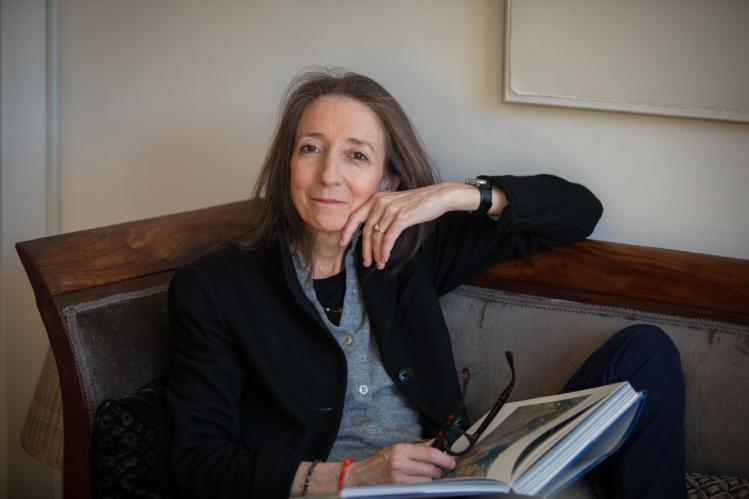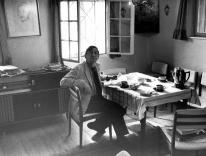
In the final poem of Day by Day, his last book, the American poet Robert Lowell questions his own lyric reliance on personal experience. “All’s misalliance,” he laments. But as the aptly titled “Epilogue” continues, Lowell doubles down. Perhaps, he hazards, the autobiographical is poetry’s proper ground. “Yet why not say what happened?” he asks. “Pray for the grace of accuracy,” he implores—for, as mortal beings, we are but “poor passing facts.” This awareness of our own mortality should “warn” us, Lowell writes, to strive for accurate depiction: in poems, in photographs, in life.
That the late American poet Saskia Hamilton takes up the same concerns—about accuracy, description, and mortality—in All Souls, her final collection, should come as no real surprise. A noted editor of Lowell’s letters, Hamilton quotes “Epilogue” itself in her own last poem. And like Lowell’s Day by Day—which was published just weeks before his death—Hamilton’s All Souls appeared only months after her own death.
Unlike Lowell’s final book, however, All Souls was written with a clear sense of death as an imminent presence. At multiple points, Hamilton refers explicitly to her own arduous experience of cancer treatment. As if mirroring the daily regimen of treatment—pills, doctor’s visits, and the like—the poems of All Souls proceed serially, even paratactically. Of the four long poems that make up the collection, three are composed in sections of associative, fragmented prose. The other—the titular “All Souls”—returns to lineation, but retains the serial quality of the accompanying prose poems.
Nor are these questions of form and technique merely incidental to the collection. Throughout, Hamilton reflects explicitly on the appropriate mode or “practice” to turn to at the end of life. “Who was it who said that every narrative is a soothing down,” she asks in the first section of “Faring.” In the next, she registers the noise of an apartment radiator: “[I]s it a hiss or a shush? An aspirant or a consolation?” This question applies to her poetry as well. In the end—of All Souls or of life itself—will poetry serve to induce hope or will it seek to console?
More often than not, the poems of All Souls move fluidly between cheap hope and false consolation in search of something sturdier, something more honest. In “Exits and Entrances to the Auditorium,” Hamilton writes:
What is the veil that writing and description put over all things?
Narrative, scene, setting, persuasion…
And then there is Antinous as Osiris, the lord of silence, transformed by Hadrian in his grief.
What practice will help prepare me.
Though phrased as a question, this last line becomes—with the notable substitution of a period for a question mark—an unanswerable statement. Having turned away, as Lowell does in “Epilogue,” from the “veil” of fiction, Hamilton pivots, in the next lines, from fiction to myth. Like Hadrian, perhaps she, too, can transfigure death into something mythic, even something divine, but the period of the final quoted line rejects that possibility as well.
Can there be such a “practice”? This question—“What practice will help prepare me”—calls to mind Franz Wright’s poem “On Earth.” There, Wright asks a similar question: “How does one go about dying? / Who on earth / is going to teach me—”. Like Wright, Hamilton doesn’t seek to avoid the inevitable confrontation with death; rather, she searches for a kind of structure, even a poetic form, that might make the unthinkable, well, thinkable.
“Structure of any kind is a form of thought,” she notes in “Exits and Entrances.” And where thought is, so the logic goes, there is life. In the same poem, Hamilton considers Revelation 8:1, in which total silence follows the Lamb’s opening of the seventh seal. “How comforting,” she remarks, “to have such precision in the midst of that terror.”
The quest for “precision” in the face of terror is, curiously enough, what gives the poetry of All Souls its sense of peace. Faced with the unavoidable reality of death, Hamilton opts for a quiet composure, a comportment of tone and feeling that refuses either mere “consolation” or simple despair. Though there is “unease beneath the day,” this sense of fear rarely troubles the surface of the poems. “Meanwhile,” she writes, “the ill among us are everywhere…making efforts at elegance.” In All Souls, Hamilton makes such an effort—though not, again, without a sense of loss or fear. This is not the poetry of a “stiff upper lip,” but neither is it one of acedia.
Instead, Hamilton’s poetry tries to hold together the irreconcilable: the reality of her own mortality and the proposition of immortality—whether by way of poetry or otherwise. Channeling T. S. Eliot’s dictum that “to apprehend / The point of intersection of the timeless / With time, is an occupation for the saint,” Hamilton writes: “Here is the place where two kinds of time intersect, moments successive and moments infinite.” Though her poetry does not subscribe, as Eliot’s does, to a Christian vision of eternity, neither does All Souls explicitly reject such theological models. Indeed, if we take the book’s title seriously, then we should pay attention to its repeated invocation of what Hamilton calls, at one point, the “crowd” of the dead. If All Souls’ Day remembers the communion of saints as those who have gone before us—and, therefore, remain beside us—then the poems of All Souls proceed with a similar disposition vis-à-vis the world of the already-dead. Throughout, Hamilton gathers a cohort of the deceased—I’m tempted to call them a “cloud of witnesses”—who appear on almost every page of the book. From Coleridge to Bishop, from Sidney to Kant, Hamilton’s poems cite a broad dramatis personae. In some books, this allusive range might serve as mere evidence of the poet’s education, but in All Souls, one senses that these names, these voices, have been summoned from the other side of death to stand alongside Hamilton, as if fortifying her courage for the road ahead.
In one section of “All Souls,” Hamilton mentions Felix Nussbaum’s paintings of crowds. “[W]here / does that line lead,” she asks, “what are they pressing // to see, their backs to us? Will we join them?” Just two pages later, Hamilton picks up this motif in a short lyric worth reproducing in its entirety:
New Year’s drizzle, nine, every church in the City
solitary. Empty roads, bus gone.
We stood on the curb looking at
Hawksmoor’s façade. The churchyard dead
were removed for the coming of the Underground.
Does it help to remember them
when hearing the sound of time?
Inside, in the long and narrow, pleas
for intercession on yellow post-its
left by the candles. A plaque for John Newton
and other former reverends unknown.
Like so much of “All Souls,” these lines devastate by understatement. They are as tragic as they are dignified. That the names of the “other former reverends” have been lost—to the poem if not to memory itself—suggests, once again, the sense of blank anonymity brought by death. “We are,” as Lowell averred, “poor passing facts.” Still, the very fact of the “plaque,” as well as the fact of Hamilton’s poem as a kind of lyric plaque, suggests that even what appears to be forgotten is never really gone. “Does it help to remember them,” she asks about those churchyard dead, “when hearing the sound of time?” Call them the “communion of saints” or, as Hamilton does later, “the multitude”; either way, in All Souls, the dead live on—in prayers, on plaques, and in poems.
Late in “All Souls,” Hamilton broaches the question of hope directly. Ostensibly out of nowhere, she asks: “Who is there now to announce the triumph / of hope?” Like so many of her questions, this one defies an easy answer—in part because, if hope is to be announced, it is unlikely to be in triumphant tones. But in one of the final sections of “All Souls,” Hamilton offers her own vision of hope. As the poem opens, she describes her view of a “small wood” from where she stands “astride / the bicycle…having arrived at a turn.” In the Romantic poetry of, say, a Wordsworth, this scene—the lonely speaker atop a hill, gazing upon nature—might have been the poem in its entirety. But, in Hamilton’s poem, even the light is “restless” and “irregular.” She might want to linger, but she can’t. So, in the poem’s final lines, she “push[es] off”:
… At play with instability,
worthy of mastery, tires going at speed
along the packed sand of a road that ran
from field to field without discernible end
in all of Europe.
The hope on offer in these lines is not triumphant. One knows, with surety, that this road does end—even if that end isn’t “discernible.” But it’s within this distinction, between what is certainly the case and what appears to be the case, that the hope in All Souls lies. That death mightnot be final; that poetry might be able to touch the infinite; that we might see, once again, all those souls who have gone into death’s darkness before us—these are the tentative hopes of Hamilton’s poetry. And they are as meaningful a parting gift as a poet can leave us.
All Souls
Poems
Saskia Hamilton
Graywolf
$17 | 72 pp.
Please email comments to [email protected] and join the conversation on our Facebook page.
Previous Story
A Literary Homeland
Next Story
Moving the Center


